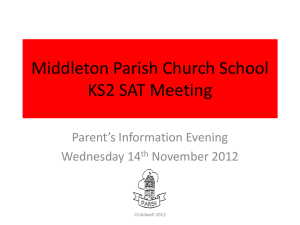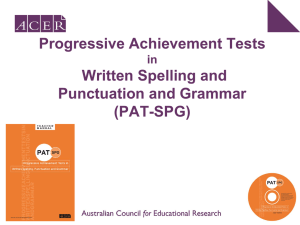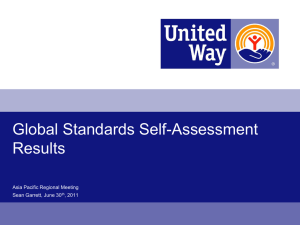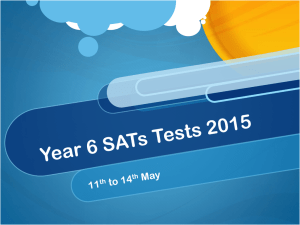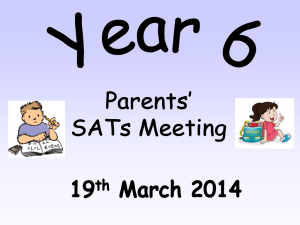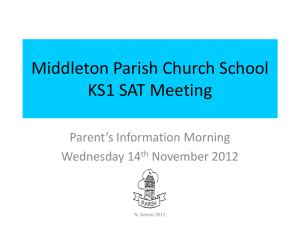KS2-SATs-meeting 2015 - Hillside Primary School
advertisement
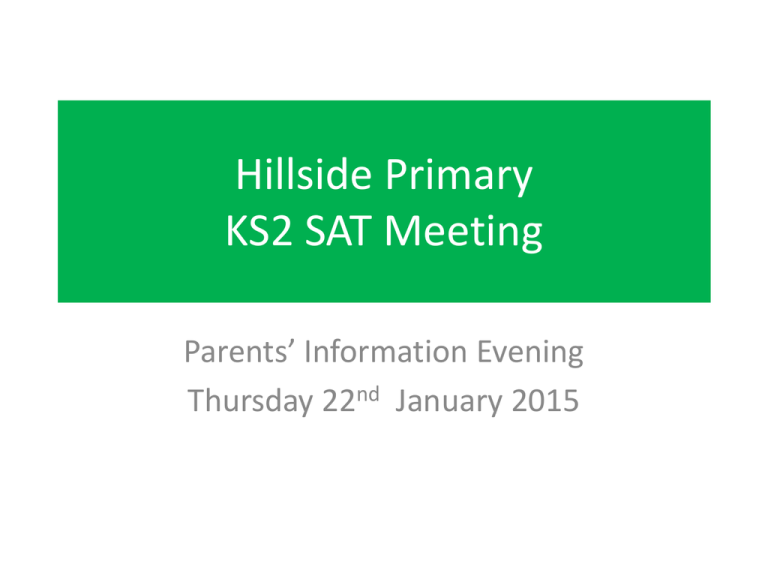
Hillside Primary KS2 SAT Meeting Parents’ Information Evening Thursday 22nd January 2015 What are SAT Tests and why do children have to take them? • KS2 SAT papers are taken by pupils in year 6 (when they are 10-11 years old) as part of the National Curriculum assessment programme. • KS2 SAT results are used by secondary schools to put the children into suitable sets for core subjects. They will also use these results to predict their GCSE grades. • Children undertake KS2 SAT papers in two core subjects: English and Maths. These are broken down into 6 separate examined tests; 5 externally marked. • Previously, pupils also took papers in Science. Annual sampling tests in Science will now take place every two years, starting in 2014. • Schools may also choose to hold Level 6 SAT assessments (in addition to their Level 3-5 SAT papers). In this scenario, we will consider their expected results before entering them for the Level 6 SAT tests as they should already be demonstrating an ability beyond Level 5 (KS3). • Importantly, the child must achieve a Level 5 in the Level 3-5 SAT tests and pass the corresponding Level 6 test in the same year to be awarded an overall Level 6 result. If the child does not pass the Level 6 SAT test they will be awarded the Level achieved in the Level 3-5 SAT test. What are SAT Levels? Level 3: Below the nationally expected level of attainment for a pupil at the end of Year 6. Level 4: The nationally expected level of attainment for a pupil at the end of Year 6. Level 5: Above the nationally expected level of attainment for a pupil at the end of Year 6. At school, we also use sub-levels as a, b or c (a being the highest). Eg. A level 4c is a low level 4, a 4b is a secure level 4 and a 4a is a high level 4. How Many Tests Are There? • Literacy Reading: • The Level 3-5 KS2 Reading SAT Paper follows the same structure as in previous years with a Reading Booklet containing several similarly themed texts. Pupils are given 15 minutes to read the texts and then 45 minutes to answer 35 individual questions about them. The questions vary in their depth with some only requiring a single word answer, others a paragraph to demonstrate strong understanding (up to three marks). Pupils can refer back to the tasks at any point. It is a classic reading comprehension assessment. • The Level 6 SAT Reading Paper is essentially just another reading comprehension assessment. Pupils are given a Reading Booklet containing several texts and then asked 25 questions about them. Pupils are allocated 10 minutes to read the texts and then a further 50 minutes to answer the questions. As with the Level 3-5 Reading Test, the Level 6 Reading Test expects some shorter answers and some longer ones, up to a maximum of four marks per question. • Literacy Grammar, Punctuation and Spelling: • Sample SAT papers for the new English Grammar, Punctuation and Spelling Test will become available in late 2012. In December 2012 the STA have published sample papers English Grammar, Punctuation and Spelling SAT papers. This includes both Level 3-5 and Level 6 sample questions. • Literacy Written: • Pupils are no longer required to take an externally examined KS2 SAT Writing Test. Instead this will now be wrapped up into an externally moderated teacher assessment. Speaking and listening tests will continue to be teacher assessed. • Numeracy Mental Test: • A 20 minute mental arithmetic paper. • Numeracy Papers: • KS2 Maths SATs papers (Level 3-5) comprise three formal papers, Test A (45 minutes, non-calculator), Test B (45 minutes, calculator allowed) and mental test. • A child's mark from all three papers are aggregated to create their overall Key Stage 2 Maths SATs level. • As with Key Stage 2 English, schools can choose to administer the Level 6 Mathematics Tests in addition to the Level 3-5 tests. The Level 6 Mathematics tests consist of two papers Paper 1 – a non-calculator paper, lasting 30 minutes and Paper 2 – a calculator available paper also lasting 30 minutes. Children's marks from both tests are aggregated to determine whether they are performing at Level 6 in mathematics. Literacy Tests • Reading • Writing (internal) • Grammar, Punctuation and Spelling Separate levels for Reading and Writing are awarded, along with an overall level for Literacy. Reading Test Examples Some questions will ask the children to find answers directly from the reading booklets they are given. Others will require the children to deduce answers by using words or phrases as evidence. Some questions will ask the children to evaluate what they have read, again using the text to back up their answers. Assessment of Writing • The written test is no longer sent away to be externally marked and assessed. • The ongoing progress of individual children is carefully tracked and developed throughout the whole of year 6: this level assessed by the teacher is used in conjunction with the written test to agree on a Level. • Local Authority moderators visit schools to ensure high standards of teacher assessment. Writing Test Examples Grammar, Punctuation and Spelling Test • Punctuation, sentence-grammar and vocabulary will all be assessed by a series of short-answer questions in a variety of formats. Some question formats will be familiar to children from the current English reading tests and some new ones will be introduced. • The spelling test will assess around 20 words and will contribute towards the whole-test score. While different methods of administration are being trialled, the method selected will be broadly in line with spelling assessment in previous National Curriculum tests. • A number of methods of testing handwriting are being trialled. If a decision is made to assess handwriting in the final tests the most appropriate method will be selected. Grammar, Punctuation and Spelling Test Examples Level 3-5 1. Circle all the adverbs in the sentence below. Open the drawers carefully and quietly when using the filing cabinet. 1 mark 2.Tick one word to complete the sentence below. Michael and Kate read their books ______________ they ate their sandwiches. Tick one. While which between during 1 mark Numeracy Tests There are three tests:- • The mental test (20%) • Paper A -no calculator allowed (40%) • Paper B -calculator allowed (40%) The tests cover Levels 3-5 • The first questions in the paper are generally Level 3 questions, moving on to Level 4, with the more challenging questions at the end of the papers targeted at Level 5. Equipment allowed in each test • No equipment allowed in the mental test. Pencil only. • Children are allowed a pencil, ruler, tracing paper, protractor and mirror for Papers A and B, and a calculator for Paper B. They may not need to use all of these. How You Can Support Your Child At Home: • • • • Sensible bedtime. Healthy diet – eat breakfast. Drink plenty of water at home and school. Encourage your child positively, without putting too much pressure on him/her. • Support with homework – provide a quiet place for work, share the targets, refer to the study guides you loaned. • Use revision guides and websites to support your child’s learning. • Read with your child, discussing the content and choice of words the author has made. Ask your child questions about their reading, encouraging them to identify words or phrases to back up their answers. SAT Week Timetable Date Level 3-5 tests* Level 6 tests* Monday 11th May 2015 English Reading Test English Reading Test Tuesday 12th May 2015 English Grammar, Punctuation and Spelling test English Grammar, Punctuation and Spelling test Wednesday 13th May 2015 Mental Mathematics Test Mathematics - Test A Thursday 15th May 2015 Mathematics - Test B Mathematics - Paper 1 Mathematics - Paper 2 Revision Websites • • • • • • • BBC bitesize www.woodlands-junior.kent.sch.uk www.compare4kids.co.uk (Excellent site.) BBC Skillswise Topmarks Count On Subtangent.com
